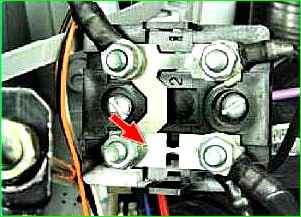Check whether the accessory drive belt is broken. If the belt is intact, check its tension
Press the top of the belt with your thumb and see how much it bends
If the deflection does not correspond to the norm, adjust its tension or replace the belt, see the article - “How to replace drive belts”

If the belt is tensioned normally, check to see if the 90 A fuse link in the fuse block located in the engine compartment next to the battery has burnt out.
This fuse link (shown by an arrow in the photo, the cover of the fuse block is removed) protects, among other circuits, the generator circuit.
If the fuse link is burnt out, replace it and start the engine.
If the voltage reading on the display is no longer blinking (the voltmeter needle is in the green zone of the scale, the low battery warning light has gone out), then the voltage is normal and you can continue driving.
Possible generator malfunctions and solutions
When the engine is running at medium speed, the voltage indicator shows below 12 V:
- Voltage regulator is faulty
Replace the voltage regulator
- The drive belt is loose
Tighten the belt
- Broken wires from terminals <+> or <Ш>
Repair the wires
- No or poor contact between brushes and slip rings
Clean the brush holder from dirt, check the force of the brush springs, clean or sharpen the contact rings
- Open circuit excitation
Eliminate the open circuit, especially carefully check the soldering points of the excitation coil leads to the slip rings and the serviceability of the coil leads
- Interturn short circuit or open circuit in the circuit of one of the phases of the stator winding of the generator
Disassemble the generator, check the stator winding for open circuits and short circuits
Replace the stator with a faulty winding
- Failure of one of the diodes of the rectifier unit
Check the diodes using instruments or a test lamp
Replace the block with faulty diodes
Look at the articles: - “Generator 1631.3701 for GAZ-2705” and “Generator 9422.3701”
Rapid wear of brushes and slip rings:
- Increased slip ring runout
Sharpen and grind the slip rings
- Oil on contact rings
Wipe the slip rings and brushes with a cloth soaked in gasoline
- Increased or decreased pressure of brush springs
Check brush spring pressure
Increased generator noise:
- Insufficient amount of lubrication in bearings
Replace bearings
- The rotor touching the starter poles
Replace the generator cover
- Bearing wear
Replace bearings
- Seized bearings
Replace bearings
- Development of a seat for the bearing
Replace the generator cover
- The tension screws of the generator covers are loose
Tighten the coupling screws to a torque of 0.5 kgf.m
Failure of the bracket and mounting arms of the generator. Frequent loosening of the generator:
- Incorrect installation of the generator on the brackets
Install generator
- Increased pulley or rotor imbalance
Check the dynamic balancing of the pulley and rotor.
If the imbalance exceeds 10 gfm, balance the parts
- Increased engine imbalance
Check engine dynamic balancing
Also see the article - “How to check the generator on a car”





